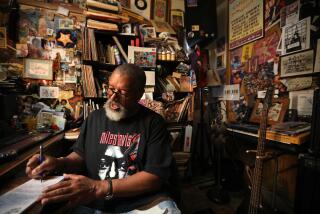Youngsters Read This Writer Loud and Clear : Tom Bethancourt Persuades Them to Be Authors at Annual Reading Conference
If you want to know what a writer looks like, look at the person next to you, Tom Bethancourt advised the 41 people in his audience.
An hour later, all 41 believed him. Each of them said he or she will write a book. Their average age hovered somewhere around 10, and their average ambition hovered somewhere around the stars.
Roomful of Kids
Bethancourt, an unlikely successful author of children’s books, had done what he set out to do: persuade a roomful of kids at Saturday’s 21st Annual Reading Conference for Young People at Claremont that they not only could but also would write books.
When he was the age of his audience, Bethancourt lived in the tough Bedford-Stuyvesant section of Brooklyn, where, he said, even the teachers played hooky.
“I thought all writers went to Harvard or Yale, wore jackets with leather patches on the elbows, smoked pipes, worked in book-lined studies with dogs on the floors and had rich families,” Bethancourt said.
He paused, and spoke his next, one-word sentence with power and conviction: “Wrong!”
Dressed in Jeans
Tomas Ernesto Bethancourt hadn’t attracted his audience’s full attention when he began talking. Small wonder. Dressed in jeans, a bright green sweater that emphasized his big belly, an Adidas jacket and a baseball cap covering white hair that snowed over his ears, the bearded writer looked more like a construction worker than a man who claims 22 books for teen-agers among his credits.
But the youngsters in the room hadn’t come to learn how to hammer nails or build skyscrapers at this reading conference sponsored by Claremont Graduate School in conjunction with the George G. Stone Center for Children’s Books, and the Alpha Iota chapter of the Pi Lambda Theta educational honor society.
By the time Bethancourt said, “Wrong!” the kids were listening as if every word was magic.
“I wish I could tell you I got out of my bad neighborhood by being a writer, but that would be a lie,” continued the 53-year-old American of Puerto Rican descent. “I was too nervous to steal, too skinny to be an athlete, too passionate to be a priest and too honest to be a cop. So I became a jazz musician.”
He adopted the name Tom Paisley, and rode it to a successful folk singing and jazz guitar career that included nightclubs and coffeehouses, television, records and appearances at political rallies.
Along the way, Bethancourt attended City College of New York where he took mostly English courses, wrote some songs, was a singing busboy at an Irish restaurant on Coney Island, wrote record jacket biographies and criticized guitar for a couple of music magazines.
In February, 1974, when Bethancourt was 41, his first child was born. “I got a late start,” he said. Because of that late start, the new father worried that his daughter, Kimi, might never know his background. He recalled thinking, “When Kimi gets to be about 14 and wants to know about her old man, I might be dead. Or, worse yet, I might be one of those old people who lie to kids.”
To be sure Kimi got a straight story, Bethancourt began writing his autobiography. He wrote it between his performances in a New York nightclub. After the first show one night, as he sat at a table by the wall printing his life story on yellow legal pads with a felt tipped pen, a customer asked if she could read his manuscript.
She read 15 pages and announced she worked for a book publisher. Six weeks later she returned with John H. Briggs Jr., president of the Holiday House Inc. publishing company.
“He offered me a book contract,” Bethancourt told his young audience.
“I said: ‘People from my background don’t write books.’
“He said: ‘I’ll give you money for it.’
“I said: ‘How much?’
“He said: ‘$1,000.’
“I said: ‘I’ll write a book.’ ”
Signed Contract
Bethancourt borrowed a pen and signed the contract in red ink then and there in the nightclub. Two years later he was showing friends his name on the cover of “New York City Too Far From Tampa Blues.” It was a volume for teen-agers, as are all Bethancourt’s books.
After relating how his first novel progressed from felt-tipped pen to print, Bethancourt changed the subject.
“How many of you speak a language other than English?” he asked. Between one-third and one-half the children raised a hand.
Most of the second languages were Spanish, but one child spoke German, another Danish, a third Taiwanese.
Bethancourt is a passionate man. He speaks with almost theatrical emphasis. He is fiercely proud of his Latino background. Never is he more passionate, more proud or more convincing than when he tells children, “Don’t think you can’t write in English if English is not your first language.” Joseph Conrad’s native language was Polish, he informed them. Thomas Mann grew up speaking German. “And I spoke ‘Spanglish’ on the streets of New York.”
Then, standing a little straighter, speaking a touch louder, this author who will travel out of his way and speak free to Latino audiences, proclaimed in “Spanglish,” “Yo soy un Newyorqueno. “ “I am a New York City-born Puerto Rican.”
Having told the youngsters that, regardless of their personal backgrounds, they could write books, he went on to persuade them of it.
All his stories, Bethancourt observed, are based on a two-word question: “What if?” Then he provided a situation:
“You’ve been transformed overnight into a large, hairy, ugly, smelly, mongrel dog,” he told the smiling children. “You wake up and you know something is wrong. How do you know that?”
Hands shoot up all over the room. “You’re hairy.” “You smell funny.” “You have hair in your eyes.” “You see in black and white.” “Your nose is too big.”
First Thing You Do
OK, so you know something’s different. Now, what’s the first thing you do in the morning?
The kids have no trouble with that one. You get out of bed. Someone pointed out that if you’re suddenly a dog, you have to learn to walk differently.
And you can’t use the toilet, observed another child.
Quickly, Bethancourt had the children moving from one situation to another. “What dangers do dogs face?” he asked. Answers shot back: “Other dogs.” “Dog catchers.” “Cars.” “Need for food.” “Need for water.” “No house to live in.”
“Good,” Bethancourt said. And he asked how a mutt might find food, water and shelter. “You’re not just going to go to the Holiday Inn and put your paws up on the counter and say, ‘I’m checking in.’ ”
A dog could live in a cave, suggested one youngster. Another recommended eating garbage. Those ideas don’t get much support from the group.
Someone observed the best thing to do is find an owner.
What do dogs do for their owners, Bethancourt asked.
A barrage of answers included doing tricks, warning of danger, acting as Seeing Eye dogs, offering love.
As Bethancourt fielded the answers, his face lit up with pleasure. Suddenly he held up a hand and declared, “Hey, wait a minute! Look what’s happened here. You’ve given me a story. In fact, you’ve given me a whole book.
“It’s quite a famous book that’s been printed in three languages,” Bethancourt said, sacrificing modesty for effect. “It’s even been made into a TV show.”
The book, Bethancourt announced, is his novel, “The Dog Days of Arthur Cane.”
“Every one of your ideas is in this book,” Bethancourt told his young audience.
“The only difference between you and me as a professional writer is that I’ve got more experience than you. That’s all.”
Well, that’s not quite all, and the kids knew it. But Tom Bethancourt had made his point. When the children were asked how many of them plan to write books, 41 hands shot up faster than you can say, “Find me an agent.”
The hour had ended, Bethancourt told the children. “In case we don’t meet again,” he said, “have a nice life. You deserve it. Don’t let anyone cheat you out of your chance. Write on!”
More to Read
Sign up for our Book Club newsletter
Get the latest news, events and more from the Los Angeles Times Book Club, and help us get L.A. reading and talking.
You may occasionally receive promotional content from the Los Angeles Times.






